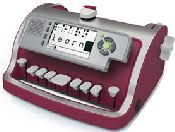Contemplating my twenty-two and a half years of school as a visually impaired student, I can divide the time into three periods: pre-technology, some technology, and the beginning of assistive technology.
Kindergarten
The half year I alluded to was kindergarten. For me, it was very disappointing. As I told my mother when I came home the first day, “I did not learn to read!” Reading was the bottom line for me. I did learn to climb the monkey bars and could even pass another student as we scooted along on the top. This was a definite achievement for a five-year-old with ten degrees of visual field. So…I dropped out and waited for first grade.
Adapting in Elementary School
Most of my adaptations in elementary school revolved around social issues and left-handedness. Keep in mind, there were no magnifiers, no CCTVs (Closed Circuit Televisions, now known as electronic magnifiers), no reading machines, or any other electronics unless you count the telephone.

During those years, I could read almost as fast as my peers. I could track with my finger and move from line to line, which helped me compensate for narrow visual fields. If I’d had a vision teacher, however, she might have taught me to use some braille tracking skills that would have worked better for me even as a print reader.
My sixth grade teacher required the class to write five to ten page papers and present the information to the class. To help me read more easily during presentations, my parents bought me a large print typewriter and I took typing lessons after school. The typewriter also came in handy when I was chosen to be the class newspaper reporter.
Shadows Were My Biggest Nemesis
Even the shadow of my hand moving across a book as I read or across paper as I wrote could affect my progress. In the 1950’s and 1960’s, classrooms were set up so light coming in through the windows came in over the students’ left shoulder. This was great if you were right handed. I was left handed and my hand cast a shadow across my paper as I wrote and obscured my vision. One way I coped was using a soft pink paper with bright blue lines and bright peacock blue ink in my pens. Fortunately, this paper was very popular with all the girls!
High School Years without Technology
High school years still did not offer any kind of electronic solutions. Reel-to-reel tape recorders were around; in fact, I got one when I was ten. No one, not my teachers and not my parents, gave it any thought to pre-record my textbooks. My tape recorder served as an audio precursor to the VCR. I was able to stay in stride academically with my peers with only one accommodation until my senior year.
A Beautiful Reading Machine
As my reading load increased, my mother became my reading machine. Her assistance was especially appreciated when I had a big paper to write. In my senior year, the school administration arranged my schedule so all of my classes were in the morning. I went home at 1:00 PM, rested my eyes for a couple of hours and then tackled my homework. Late in my senior year, my mother became a volunteer for Learning Ally (formerly known as Recording for the Blind). There they were—textbooks recorded on reel-to-reel tape. However, at that time, only college textbooks were recorded.
Stacks of Reels in College Days
So…in the fall of 1965 off to college I went with stacks and stacks of reel-to-reel recorded books. Just imagine books for four courses stacked in every corner of my side of the dorm room! Even though each tape held six hours of reading, some of the books were ten tapes long or should I say ten tapes high! When Side One finished, each reel was carefully removed from its spindle, turned over, and replaced on the recorder. This had to be done four times per tape, with each tape having four tracks. Occasionally a tape would get twisted or break. What a nightmare! But these tapes were better than nothing. In the late 60’s, the cassette recorder appeared and Recording for the Blind began producing books on cassette. For visually impaired students it was like the invention of the wheel!!
The Expense of Adapting to Modern College
Fast forward to 1987, when I returned to college and I owned an IBM PC with electronic speech produced through a $2500 motherboard. Class notes were recorded with an adapted tape recorder and later transcribed into braille with a Perkins braillewriter. Tactile graphics were created with a thermoform machine or special foil paper and special stylus. There were still no notetakers or braille embossers and Kurzweil readers cost $25,000! Yes, I have the comma in the correct place.
How Technology Changes

Just nine years later, when I started teaching at Florida State University (FSU), the department provided a Pc with speech software that cost less than $1000. The Kurzweil Reader that no individual could own independently was replaced with OCR software that also cost less than $1000. I had a note taker with braille display and a braille embosser. Each of those cost less than the motherboard in my first computer.

The only “technology” that remained the same between kindergarten and teaching at FSU was the telephone…except, the phone had a rotary dial and three neighbors had to share the line, but that’s another story!
Further Reading
Lessons Learned in the School of Life Part One
Lessons Learned in the School of Life, Part Two
Lessons Learned in the School of Life: Going to School with the Dinosaurs
Back to School Tips for Older Students Who Are Blind or Visually Impaired